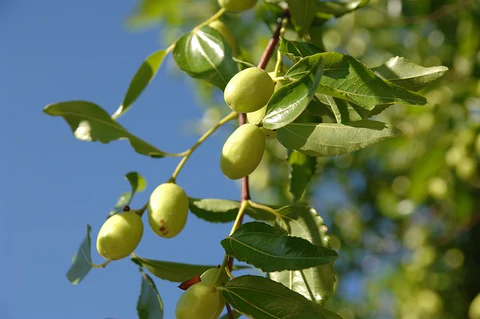What is a Jujube Tree?
Are you looking to grow a unique fruit tree that’s both low-maintenance and packed with health benefits? Or maybe you’re curious about how to cultivate a resilient tree that can handle tough climates?
The jujube tree, scientifically known as Ziziphus jujuba, is a fruit-bearing tree that produces small, round, or oval fruit. Jujube fruit, also known as red or Chinese date, is native to Southern Asia but has become popular around the world.

The fruit is initially green and crisp, like an apple, but turns reddish-brown and becomes wrinkled as it ripens, resembling a date. This hardy tree is valued for its ability to thrive in a wide range of climates, particularly in areas with hot summers and cold winters.
Jujube fruits are not only sweet and enjoyable to eat but also packed with health benefits. They are rich in vitamin C, antioxidants, and fiber, making them great for boosting immunity, relieving stress, and aiding sleep.
Why Should You Grow a Jujube Tree?
-
Easy to grow and care for: The trees are drought-tolerant and require minimal maintenance.
-
Climate versatility: Jujube trees adapt well to dry, sunny climates, making them ideal for regions with high temperatures.
-
Health benefits of jujube fruit: Jujubes have been used in traditional medicine for their health benefits, including aiding digestion, improving sleep quality, and boosting immunity.
Benefits of Jujube Fruit
Jujubes are not only tasty but also offer significant health benefits. According to Healthline’s article about the nutrition of jujube, this fruit is packed with vitamin C, antioxidants, and fiber, making them a great natural remedy for boosting immunity, and enhancing digestion. A long-standing remedy in traditional medicine, jujubes are believed to support better sleep quality and relaxation due to compounds that may have calming effects.
Beyond their health benefits, jujube trees can enhance soil quality and biodiversity, making them a valuable addition to both home gardens and commercial orchards.
Perfect as a snack, jujubes add a unique, crisp taste to salads and recipes, especially when using varieties with a slightly sweet, tangy flavor.
Varieties of Jujube Trees
All jujubes are self-fruitful, meaning you only need one to get fruit, and all contain a pointed seed.
‘Li‘ is the one to plant if you have room for only one tree. Fruits are abundant, round, 1-1/2 to 2 inches in diameter, and sweet. It matures early, a great benefit in short-growing-season areas.
‘Lang‘, compared with ‘Li’, is taller, and the fruit is a bit more elongated or pear-shaped, about 3/4 inch in diameter and 2 inches long, and has thicker skin. The fruit is a bit less sweet than that of ‘Li’ and is best eaten dried. Branches are nearly thornless.

Honey Jar Jujube – This fruit is small to medium-sized, with a round to elongated shape. It’s exceptionally sweet and crisp, similar to sugar cane, making it perfect for fresh eating. The tree can grow up to 20 feet tall.
GA866 Jujube is a variety of jujube trees known for its sweet and crisp fruit. Recognized for its large, oblong fruits with dense clusters and a very sweet, honey-like taste.
Sugar Cane: Known for a taste and crunch similar to sugar cane, with high sweetness, making it a favorite for fresh eating.
Where to Buy Jujube
When it comes to buying a jujube tree, sourcing it from a reputable nursery or online store is essential to ensure a healthy, disease-free plant.
Trees are available in nurseries in the West and Southwest, both as bare-root in winter or in containers during the summer. You can order jujube trees from several mail-order nurseries.
Also, online at Garden Plant Nursery!
Planting Jujube Tree
Where to Plant Jujube
Jujube grows throughout most of the southern half of North America. For best crops, the tree needs a long growing season and hot and dry weather during ripening. About the only parts of the United States where jujube can’t grow are in the North (USDA Zones 5 and colder) and the Gulf Coast, where summer rain and humidity prevent optimum fruiting.
Although average winter minimum temperatures between -5° F (zone 6) and -15° F (zone 5) are the likely hardiness limits, trees have survived -25° F.
When to Plant Jujube
The best time of year to plant jujube trees, or Ziziphus jujube, is early spring, or late winter when the risk of frost has passed, and the soil starts to warm up. This gives the tree ample time to establish its root system before the heat of summer. In regions with milder winters, jujubes can also be planted in early fall to give them a head start.
With proper care, including well-drained soil and full sun exposure, these cold-hardy trees will thrive and begin producing fruit by early summer, offering dark brown, delicious jujubes ideal for fresh eating. For best results, consider regional conditions: in warmer climates, planting in autumn is also effective, allowing the jujube tree’s roots to establish and grow before winter arrives.
How to Plant a Jujube Tree
-
Dig a hole: Dig a hole about 12-16 inches deep and wide enough for the root ball.
-
Position the tree: Place the tree in the hole, fill it with soil, and press down firmly to eliminate air pockets.
-
Water generously: After planting, water the tree thoroughly to help settle the soil around the roots.
Planting jujube trees from seeds
- Seed Preparation: Jujube seeds have a hard outer shell, so they benefit from a process called scarification, where you gently file or sand the seed coat to help with germination. Afterward, soak the seeds in warm water for 24 hours to further soften them.
- Planting Medium: Use a well-draining potting mix, preferably one with sand or perlite to mimic the natural conditions jujube trees thrive in. Plant the seeds about an inch deep.
- Germination: Place the pot in a warm, sunny spot. Jujube seeds need warmth to sprout, ideally around 25-30°C (77-86°F). Keep the soil moist but not soggy—too much water can cause rot.
- Patience Required: Jujube seeds can take several weeks to a few months to germinate. Be patient, and keep checking on moisture levels.
- Transplanting: Once your seedlings reach about 4-6 inches in height, they’re ready for transplanting. Jujube trees prefer a sunny location with well-drained soil outdoors.
Growing jujube trees from seed takes time, but the result is a resilient, drought-tolerant tree that produces delicious, nutritious fruit.
Growing Jujube Trees
Once you’ve planted your tree, caring for it is relatively simple. Here are a few essential tips to keep your jujube tree healthy and productive.
Maturation Phases:
- White Mature: The fruit is nearly full-sized with a greenish-white skin.
- Crisp Mature: The fruit reaches full size, with partially reddish-brown skin; it is sweet and crisp.
- Fully Mature: The skin turns completely red and wrinkled, offering a very sweet but drier fruit.

1. Key Factors for Optimal Growth
-
Temperature: Jujube trees thrive in temperatures between 68-95°F (20-35°C). They can tolerate colder temperatures in winter but might need protection if it’s extremely cold.
-
Humidity: These trees prefer moderate humidity and don’t require excessive moisture like other fruit trees.
2. Watering and Fertilizing
-
Watering: During dry seasons, water the tree once or twice weekly. Ensure the soil remains slightly moist without becoming waterlogged.
- Fertilizing: While jujube trees don’t require much fertilizer, adding organic compost or manure once a year can encourage growth and fruit production.Applying a balanced fertilizer in early spring supplies essential nutrients to newly planted trees, fostering strong root systems and boosting fruit production as they begin the growing season. For best results, test your soil pH and adjust the fertilization schedule to encourage vigorous growth and yield healthy, dark brown jujubes ideal for fresh eating.
3. Pruning and Shaping Your Jujube Tree
Pruning is essential for keeping your jujube tree healthy and promoting better fruit production.
-
When to prune: Prune your it in late winter or early spring before new growth begins.
-
How to shape the tree: Remove any weak, broken, or crossing branches to allow better air circulation and sunlight penetration.
4. Pest and Disease Control
Jujube trees are relatively resistant to pests and diseases, but it’s still a good idea to watch for common issues like powdery mildew or leaf-eating insects. Organic pest control methods or natural insect repellents can effectively protect your tree without harming the fruit.
Harvesting and Storing Jujube Fruit
One of the most rewarding parts of growing a jujube tree is enjoying the fruits of your labor! Here’s what you need to know about harvesting and storing jujube.
-
When to harvest: Jujube fruits are typically ready for harvest in the fall when they turn reddish-brown.
-
How to store: Fresh jujubes can be dried or stored in the refrigerator for a longer shelf life. You can also make jujube syrup or jam for an extended supply.
FAQ About Growing Jujube Trees
-
How often should I water my jujube tree?
Water the tree once or twice a week during dry periods. In rainy seasons, you can reduce watering. -
Is a jujube tree easy to grow?
Yes, jujube trees are low-maintenance, drought-tolerant, and suitable for beginner gardeners. -
How long does it take for a jujube tree to bear fruit?
Most jujube trees begin fruiting within 3-4 years, depending on growing conditions. -
What are the health benefits of jujube fruit?
Jujubes are rich in vitamin C, antioxidants, and dietary fiber, which support immune health, better digestion, and better sleep quality.
A jujube tree is a fantastic addition to any garden. It provides low-maintenance care, excellent adaptability to dry climates, and delicious fruit with impressive health benefits. I hope this guide has inspired you to plant your jujube tree and enjoy its many rewards! Also, at our shop, we offer a wide range of juicy and sweet fruits. Visit us to explore some expert tips for your thriving garden.
